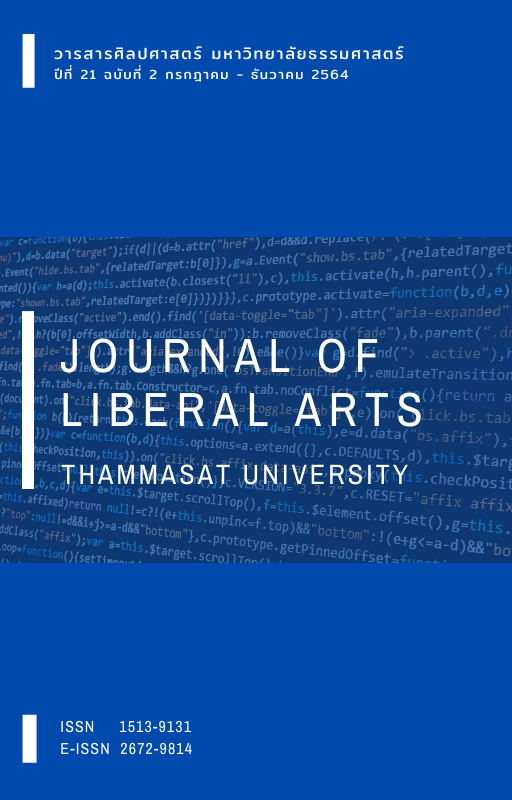Buddhist Sinification and Multicultural Society in China during the Third and Sixth Centuries
Main Article Content
Abstract
This article analyzes the causes behind the establishment of Buddhism in China and its interaction with traditional Chinese beliefs. It reveals that the most critical period of its foundation was between 3rd and 6th century when China was fragmented. Its traditional beliefs which had been rooted since the Han period came under question and led to the emergence of new thoughts, such as Xuanxue (Neo-Daoism), and Religious Daoism. Buddhism was among those and gradually gained recognition from the upper class before it eventually flourished in China by adjusting itself to fit in the new cultural settings.
Downloads
Article Details

This work is licensed under a Creative Commons Attribution-NonCommercial-NoDerivatives 4.0 International License.
References
Edward, L. E. (2009). China Between Empire: The Northern and Southern Dynasty. Cambridge: Harvard University Press.
Fang, L. T. (1989). A Tentative Discussion of the Characteristics of Chinese Buddhism. Chinese Studies in Philosophy, 20, 3-71.
Guang, X. (2015). Conflict and Harmony between Buddhism and Chinese Culture. International Journal of Buddhist Thought & Culture, 25, 83-105.
Liu, J. L. (2006). An Introduction to Chinese Philosophy: from Ancient Philosophy to Chinese Buddhism. Oxford: Blackwell.
Mair Victor, H. (2010). What is Geyi Afterall?. In Alan K. L. Chan & Yuet-Keung Lo (Eds.), Philosophy and Religion in Early Medieval China (pp. 227-264). Albany, New York: SUNY Press.
Robinet, I. (1997). Taoism: Growth of A Religion. Stanford: Stanford University Press.
Timothy, B. (1993). Rethinking Syncretism: The Unity of the Three Teachings and their Joint Worship in Late-Imperial China. Journal of Chinese Religions, 21(1), 13-44.
Walter, L. (1955). Chinesse Buddhism During the 4th and 5th Centuries. Monumenta Nipponica, 11(1), 44-83.
Zürcher, E. (1972). The Buddhist Conquest of China: The Spread and Adaptation of Buddhism in Early Medieval China (3rd ed.). Leiden: Brill.
Cai Shangsi. (1991). 蔡尚思:《中国礼教思想史》,香港:中华书局,1991年。
Gao Wenqiang. (2006). 高文强:“东晋南朝士人与佛教之关系浅析”,载《宗教学研究》,2006年第3期,第72-77页。
Hu Jun. (2004). 胡军:“儒釋道:紛爭與融和”,载《普門學報》,2004年11月第24期,第355-385頁。
Ji Xianlin. (2007). 季羡林:《佛教十五题》,北京: 中华书局,2007年。
Jiang Weiqiao. (2011). 蒋维乔:《中国佛教史》,湖南湘赣市:湘赣大学出版社,2011年。
Lao Siguang. (2005). 劳思光:《新编中国哲学史》二卷,桂林:广西师范大学出版社,2005年。
Liu Xuezhi. (2011). 刘学智:《中国哲学的历程》,桂林:广西师范大学出版社,2011年。
Fang Litian. (1991). 方立天:“中国佛教哲学思维方式德类型和热点”,见《中国佛教文化》,北京:中国人民大学出版社,2012年,第117-128页。
Fang Litian. (1995). 方立天:《魏晋南北朝佛教论丛》,北京:中华书局,1995年。
Fang Litian. (2012). 方立天:《魏晋南北朝佛教》,北京:中国人民大学出版社,2012年。
Feng Youlan. (1998). 冯友兰:《中国哲学史新编》中卷。北京:人民出版社,1998年。
Gao Wenqiang. (2006). 高文强:“东晋南朝士人与佛教之关系浅析”载《佛教學研究》,2006年第24期,第72-77頁。
Ren Jiyu. (1990). 任继愈(主编)。《中国道教史》,上海:上海人民出版社,1997年。
Tang Yongtong. (1991). 汤用彤:《理学、佛学、玄学》,北京:北京大学出版社,1991年。
Tang Yongtong. (2010). 汤用彤:《魏晋玄学论稿及其他》,北京:北京大学出版社,2010 年。
Xie Shiwei. (2012). 谢世维:“融合与交涉:中古时期的佛道关系研究回顾”,载《清华中文学报》,2012年第8期,第263-299页。
Yu Yingshi. (1980). 余英时。《中国知识阶层史论》,台湾新北市:联经,2019年。
Zhang Guangbao. (2013). 张广保:“魏晋南北朝道教、佛教思想关系研究”,载《宗教学研究》,2013年第4期,第1-14页。
Zhang Jiacheng. (2011). 张家成:《中国佛教文化》,杭州:浙江大学出版社,2011年。
Zhang Lizhu. (2010). 张丽珠:《中国哲学史三十讲》,北京:北京师范大学出版集团,2010 年。
Zhang Rongming. (2018). 张荣明:《儒释道三教论》,北京:商务印书馆,2018年。
Zhou Yao. (2006). 周瑶:“从佛教中国化的过程略论中国传统文化的主体”,载《和田师范专科学校学报》(汉文综合版),第26卷第二期,第103-104页。

